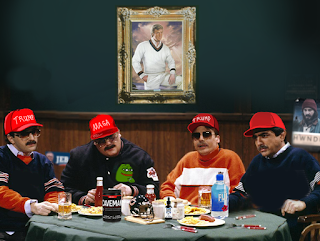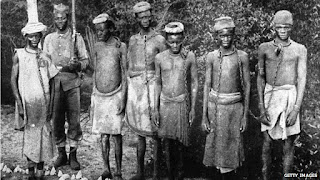The denial of racism is gradually conquering the sphere of manifestations of racism and becoming the most typical and widespread modern form of appearance of racist attitudes, opinions, statements, actions and policies. There are several types of denial of racism and their implications in our society today. Finally, I will illustrate the foregoing by pointing out some rhetoric forms of denial—Now let’s begin.
Denial: the new phenomenology of racism.
For example, let’s make Virginia a case study. the Governor and the Attorney general are currently battling a blast from the past and guess what, they are not willing to resign but instead they are both taking responsibilty and still justifying it; that they were young and stupid. And with Trump still occupying the White House, I don’t see them resigning because racism has become the new norm all across the world and especially in USA.
For the purposes of this article, I assume that (1) all societies are racist to some degree (2); racism is ubiquitous at least at the level of attitudes and its presence is not necessarily visible at the level of social behavior (3); the existence of racism is widely denied across cultures, with varying degrees of disguise (4); acknowledgement of racism is a prerequisite (but not at all a guarantee, or a bridge) to overcoming it.
The concept of racism is meant here in the entirety of its broad scope and polysemy (plurality of meaning). “Racist” can be a description of attitudes (mental states of individuals or groups), ideologies (sets of socially constructed and politically functional ideas of whole societies, classes, cultures, etc.), social practices, institutions, etc. Of these, human rights advocates and international organisations have addressed issues of racism mostly in respect to social practices. This is understandable. While racist beliefs and attitudes can be present in a person’s mind with varying degrees of conviction, awareness, scope and intensity, we can define somewhat less vaguely, and prohibit by law, racist acts as acts which contribute to ethnic or racial inequality in society.
Critical race theory, a recent legal philosophy, the inception of which can be traced to a 1989 workshop in Madison, Wisconsin, USA, understands racism broadly. “Racism is viewed not only as a matter of individual prejudice and everyday practice, but as a phenomenon that is deeply embedded in language and perception. Racism is a ubiquitous and inescapable feature of modern society, and despite official rhetoric to the contrary, race is always present even in the most neutral and innocent terms. Concepts such as ‘justice’, ‘truth’, and ‘reason’ are open to questions that reveal their complicity with power. This extraordinary pervasiveness of unconscious racism is often ignored by the legal system2.”
There exists a large body of literature on research and measurement of racist attitudes, in the wake of the classic study by Theodor Adorno and others, The Authoritarian Personality (1950), identifying and measuring ethnocentrism, anti-Semitism, fascizoid attitudes, and susceptibility to anti-democratic propaganda in the United States. I believe that this study remains relevant to the understanding of the social psychology of racism today, and deserves to be re-discovered by the anti-racist movement. Adorno’s team established “an anti-utopian syndrome” in the so-called “high-scorers” – the individuals who scored high on several scales, registering a more or less stable personality structure, which makes individuals susceptible to anti-democratic propaganda. The analysis of the survey questionnaires and interviews showed that, according to these individuals, there will never be, and there should not be, Utopia: “one has to be realistic.” But, in their case, “realism” is not meant as the need to judge and decide on the basis of objective, factual insight. It is meant rather in the sense that the overwhelming power of the existing order over the individual and his intentions is taken for granted. The antipodes of the “authoritarian personality”, the so-called “low-scorers”, usually also display an anti-utopian mind-set, but in an entirely different way. While “high-scorers” share in the official optimism, accompanied by deeper-lying motives of contempt for human nature, and by a basic cynicism, “low-scorers” more readily express negative facts, are less affected by the conventional cliché that “everything is fine”. However, they demonstrate, at a deeper level of their opinions, a much greater trust in the innate potentialities of the human race. While “high-scorers” ultimately do not want Utopia, “low scorers” are skeptical because they take seriously the possibility that Utopia can be realised. They therefore are critical of the existing order, even to a point where they acknowledge the threat of existing conditions to ruin just those human potentialities that they bank upon in the depth of their souls3.
Can we talk of racism in a historic sense; was there “racism” in slave owning, or in feudal societies? Or is racism a phenomenon of modern history, which emerged with the rapid expansion of biological, evolutionary, and genetic descriptions of living order? Without going into this debate, I will limit my observations to one point: having accepted a very broad definition of racism, and fully aware of the risks of anachronisation, we might benefit today from understanding racist attitudes as present throughout history. In ancient Greece and Rome, we may then say, racism was typical of the treatment of slaves and metekoi (foreigners residing in the city), and reached extreme forms of expression in such places as the Greek ergasterion – that special prison, in which slaves – as a rule ethnically different from the locals – were engaged in the hardest labour4.
“Race” was regarded as a biological concept, while discrimination on racial grounds was denounced. However, racial discrimination and racism were applicable, from the point of view of communist ideology, to cases such as the treatment of blacks in the USA, apartheid in South Africa, and similar “black and white” issues, whereas neither racism, nor racial discrimination were acknowledged as a possibility in the context of “socialist society”. This political localisation of racism was at odds with the more general and certainly much more sophisticated Marxist treatment of the relation between nature and society/culture; a divorce between the universality of the theoretic claim and the limited political impositions of the theory was typical of Marxist ideology – as, indeed, of any “ideology” in the sense of Mannheim5.
Thus, the societies of post-communist (post-1989) Central and Eastern Europe were unprepared to accept the more general definition of racial discrimination as found in international law, especially in the UN Convention on the Elimination of All Forms of Racial Discrimination. In the first half of the 1990s, the governments and the political classes of the region were – and in many places still remain – outraged by the very suggestion that one can speak of anti-Roma racism in Eastern Europe. Courts, too, have failed to apply the concepts of “race” and “racial discrimination” in the broader sense in which they are construed in the UN (ICERD) framework. On October 30, 1995, non-Romani persons on a train in the Czech Republic threatened to beat up and throw from the train four Romani passengers. Perpetrators were subsequently prosecuted and charged with, inter alia, racially motivated violence. On 20 November 1996, the District Court in Hradec Králové acquitted the defendants stating that the Romani victims were not a distinct racial group and “belong(ed) to the same race” as the defendants (ethnic Czechs). In so holding the Court relied on a narrow biologically-rooted definition of race according to which Roma, like Czechs, are members of the same “Indo-European race”. The Court declined to impose punishment on either defendant6.
Cognitively, there can be different grades of consciousness, or awareness of racism: from totally explicit awareness to hidden assumptions and merely lived experience or habit. For instance, people may be unable to formulate general racist or ethnocentric principles as such, but they know that they disapprove of facilitating immigration, or preferential job allocation to minorities. Levels of awareness of racist attitudes can also be dependent on whether such attitudes form part of a dominant ideology. As Teun A. van Dijk notes,
Whereas oppositional ideologies by definition will tend to be more explicit and conscious among group members, dominant ideologies will precisely tend to be implicit and denied, or felt to be ‘natural’ by their members. Such group members may indeed be unaware of their ideologies (typically so of male chauvinism, racism, etc.) until they are challenged by members of the other group7.
Much of Stanley Cohne’s discussion of denial of human rights violations in his 1995 Denial and Acknowledgement is highly relevant to the case of denial of racism. Cohen analysed denial in the sense of “how people react to the suffering of others8.” But what he says about the ways in which people react to information about suffering caused by human rights violations, applies to the experience of racism and its deeds. “Denial of racism” is meant below in the sense that (a) the suffering of victims of racism, (b) the existence of attitudes in oneself or society which makes this suffering possible, and/or (c) the existence of practices and institutions of racism, are denied.
The denial of racism is a reaction to the post-World War II sanction of racism as a socially unacceptable opinion9. In my view, racism’s presence is denied more vehemently in those cultures, which, following WWII, have done more to limit racism and related intolerance. Denial is a manifestation of a certain level of accomplishment in implementing a human rights and anti-racism agenda in a society. The more progress a society has made in denouncing racism as a social and political evil, the more vehemently is its continued existence denied. Ironically, the denial of racism is a product of the progress of the struggle against it. In Western democratic societies, for example, most people who share racist opinions and act accordingly, would deny that they are racist – because racism is officially and culturally condemned, while tolerance, racial equality and human rights are dominant ideological values. Thus, at present racism is rarely a self-description; increasingly, and under the influence of Western democracies and the international anti-racism movement, it is becoming mostly a label applying to groups or individuals as perceived by others. Although explicitly racist groups and parties exist, the larger part of today’s “racists”, who hold people of certain ethnic background in contempt or hostility, at the same time oppose being described as “racists”. Austria’s Freedom Party experienced a dramatic rise in popularity following a change of leadership in the mid-1980s, which brought the demagogic, charismatic Jörg Haider to its head and with him a newly invigorated populistic, anti-foreigner language, together with renewed belittling of Austria’s complicity in the racist crimes of the Third Reich. Nevertheless, most of the party members and supporters deny its racist character.
Closing Argument
Racism in the black community is real. I watched the video of a Black American woman telling an African woman to “hop back on the banana boat you came to America with”—Yes a Black American said that to a black African. Racism will be with us for a long time! I don’t see colors, age, sexual preference or the weight of a person, what i see is just another human who breathe same air like me and have the same color of blood exactly like me. We can do better as humans.











